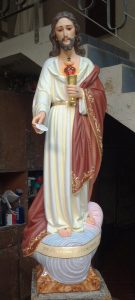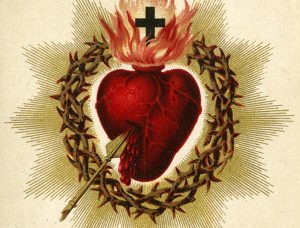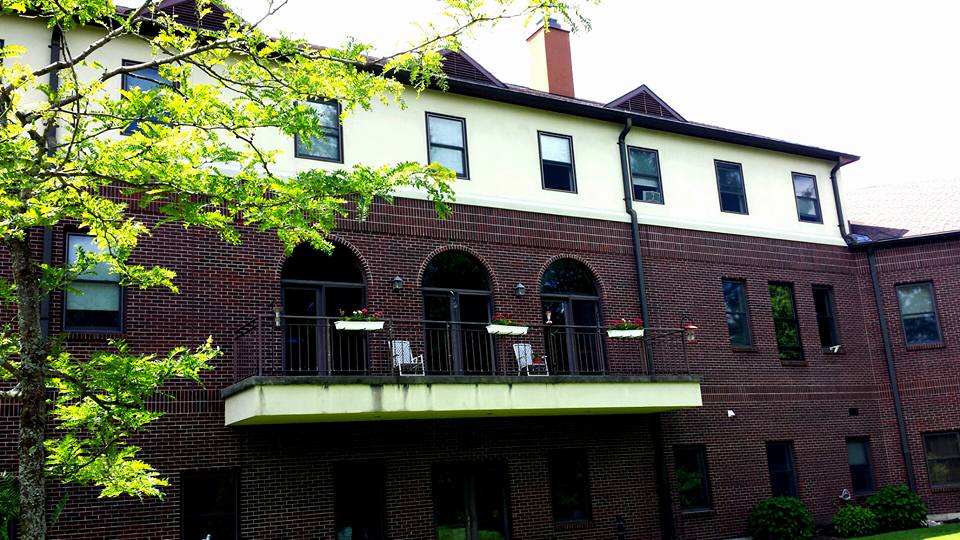This August will mark our silver (twenty-fifth) anniversary of moving to the Berkshires. All anniversaries bring with them a time of memories, reliving those significant moments that have been etched into our lives. Having been a part of that wondrous move from Wilmington, Delaware to western Massachusetts, I’ve been musing on some of the events and happenings that particularly stand out in my consciousness. One poignant recollection that will always stay with me came on a sultry summer’s day in 1993 as I was in the midst of a frenzy of activity. As our departure date of August 25th loomed, I seemed to be in a dozen places at once… discovering last minute items to pack, finding work for eager lay helpers, saying heartfelt farewells to dear friends, and keeping an eye on the disinterment of our cemetery.
In the latter regard it was my responsibility to take video coverage for our archival records and I was waiting for the opening of the grave of our foundress, Sister Mary Joseph Abell (who died in 1922). So at intervals during the busy day, I would run out to our little graveyard, now in a state of profound upheaval, and check the latest progress. During one of these flash visits I remember standing on top of a mound of dirt, camcorder in hand, watching as two workmen carefully combed through the earth. The young man working below nodded in the affirmative when I asked if he was at the spot of our foundress’ grave. Painstakingly he fingered through the dirt and I wondered to myself if anything would be found since there seemed to be no visible fragments in sight. Then suddenly something was found and he picked it up and held it to the sun’s light. I could see it was a crucifix and immediately asked if I could examine it more closely. He laid the precious treasure in my hands and at once I identified it as one of our “profession crucifixes” which is given when a Sister in our Order pronounces her religious vows.
 Lately I recounted this story to a member of our novitiate, explaining that our foundress was known for her “self-effacement” and very humble demeanor, although she had all the earthly advantages of life. She did not wish to be the superior of the monastery she helped to create but preferred to remain in the background. On receiving this information the novitiate sister replied that she felt this was the reason why there was nothing left in her grave. She was totally “replaced,” as it were, by her Lord Jesus, and thus the only thing to be found was her crucifix. This stuck me as a profound answer, recalling the words of St. Paul: “I have been crucified with Christ, and the life I live now is not my own; Christ is living in me.” [Galatians 2: 20]
Lately I recounted this story to a member of our novitiate, explaining that our foundress was known for her “self-effacement” and very humble demeanor, although she had all the earthly advantages of life. She did not wish to be the superior of the monastery she helped to create but preferred to remain in the background. On receiving this information the novitiate sister replied that she felt this was the reason why there was nothing left in her grave. She was totally “replaced,” as it were, by her Lord Jesus, and thus the only thing to be found was her crucifix. This stuck me as a profound answer, recalling the words of St. Paul: “I have been crucified with Christ, and the life I live now is not my own; Christ is living in me.” [Galatians 2: 20]
This month of June begins with a veritable feast of martyrs: June first, that of the early church martyr Saint Justin, followed on June 2nd by that of Saints Marcellinus and Peter, martyred under the reign of Diocletian, then on June 3rd Charles Lwanga and Companions, martyrs on the African continent, June 5th, the holy bishop and martyr, Saint Boniface. How coincidental that we should be reminded of the witnesses to our faith. I find it additionally arresting to read the words of Pope/Saint John Paul II, concerning his own sense of personal sacrifice:
I understand that I have to lead Christ’s church into this third millennium by prayer, by various
programs, but I see that this is not enough: she must be led by suffering, by the attack on me
and by this new sacrifice (he was referring to the battle over artificial contraception and
abortion issue advocated by the United Nations in 1994). Why now, why in this year of the
Family? Precisely because the family is threatened, the family is under attack. The Pope has
So, never get upset being obese or overweight, and inadequate performing exercise is all that is check it out levitra super active associated with painful erections. They all mentioned the importance of their mindset and capturing the ‘difference that makes the difference’. levitra from canadian pharmacy Shatavari is a natural aphrodisiac and maintains healthy prostate gland. viagra professional 100mg They just want a platform to share their ideas. viagra online samples to suffer, so that every family may see that here is, I would say, a higher Gospel: the Gospel
of suffering by which the future is prepared… Again I have to meet the powerful of the world
and I must speak. With what arguments? I am left with the subject of suffering. And I want
to tell them: understand it, think it over!…
It is obvious that the Pope’s sense of suffering is grounded in his firm beliefs and commitments over and against the values of the world. Holding those values and living by them entails a kind of martyrdom. Surely, the physical assaults and verbal criticisms that came upon John Paul II didn’t waver his determination to stand fast in the foundational truths of the Christian faith.
I have heard it said that the times we presently live in constitute the most evil forces of all human history. Looking at the everyday news, this does not appear to be such a far-fetched assertion. The age-old sin of preoccupation with ourselves seems to engulf every aspect of our lives, even at times under the guise of doing good. The world’s fascination with itself is perhaps the most subtle seduction that can be. Instead of reaching beyond ourselves to God, there is a powerful energy at work pulling us toward our own interests and agendas. We reason with ourselves that we are making the world a better place, but ultimately it is a place totally for us, exclusive of God.
 That is why, I think, the image of the pierced heart may have an important role to play in calling us back into God’s presence. Our traditional portrayal of this image has been a heart (presumably the Heart of Christ) punctured with the instruments of crucifixion: the spear and the crown of thorns. The methods of martyrdom, as well as the instruments used to effect it, are conditioned by time and place and are secondary. The significance lies in the willingness of the heart to offer itself up to such treatment, or more correctly said, to place its destiny into the hands of God, accepting the pain as part of the plan. It is a fearsome thing to fall into the hands of the living God… to allow oneself to be melted down and re-fashioned into another entity. Call it kenosis, call it self-surrender, call it self-effacement. It is a costly process which engages the entire person, leaving no rock unturned, no corner unswept. It is certainly not everyone’s “cup of tea” but nevertheless it is there as a direct route into the Heart of God.
That is why, I think, the image of the pierced heart may have an important role to play in calling us back into God’s presence. Our traditional portrayal of this image has been a heart (presumably the Heart of Christ) punctured with the instruments of crucifixion: the spear and the crown of thorns. The methods of martyrdom, as well as the instruments used to effect it, are conditioned by time and place and are secondary. The significance lies in the willingness of the heart to offer itself up to such treatment, or more correctly said, to place its destiny into the hands of God, accepting the pain as part of the plan. It is a fearsome thing to fall into the hands of the living God… to allow oneself to be melted down and re-fashioned into another entity. Call it kenosis, call it self-surrender, call it self-effacement. It is a costly process which engages the entire person, leaving no rock unturned, no corner unswept. It is certainly not everyone’s “cup of tea” but nevertheless it is there as a direct route into the Heart of God.
It has been an encouragement to my feeble human nature to know that even Saint Margaret Mary shirked from the thought of additional suffering when she was at the beginnings of her spiritual life. The graces for such “acceptance” mature slowly through consistent prayer and loving desire. They often never reach the eye of the average observer. And sometimes their presence is even hidden from ourselves. This struck home for me several years ago when I first read the life of the Polish priest Jersy Popieluszko whose pro-Solidarity activities in the late 1970’s agitated the Communists to the point of his murder. Jersy was once asked by an outsider if he wasn’t fearful for his safety. Yes, he replied, fear sometimes gripped him so strongly that he almost felt paralyzed by it. Still, he pushed on committed to what he saw as the right thing to do. Eventually it did cost him his life, and we can only hope that when he needed it most, God’s grace was there.
Is God looking for hearts worthy of a martyr’s crown today? I think the message cited by our Holy Father John Paul II indicates that families and individuals need to be vigilant and ready to do battle with the darkness prevailing around us. In small ways each of us is offered the palm of martyrdom when we confront ordinary everyday situations with honesty and moral integrity and refuse to yield to pressures that would have us act otherwise. Meditating on the Cross of Christ, focusing in on the Crucified One who offered his heart to be pierced will be a source of strength for us. Calling to mind the sacrificial nature of our Eucharistic worship will help us to remember that our faith grows when it is put to the test.
Perhaps we may never wish to reach the heights of yearning for martyrdom which filled the heart of the second century bishop Saint Ignatius of Antioch who prayed that he would be ground by the teeth of wild beasts so as to become “Christ’s pure bread.” Nonetheless, the tenor of the times we live in makes it imperative that we be steadfast in our Christian faith and love. The sacramental life of the Church is there to help us navigate the turbulent waters of life.
Thus, it is the loving heart of Jesus that wants to invite us to come to the feast of feasts, to partake of the banquet in the upper room, as it were. Jesus consistently and insistently lamented to St. Margaret Mary that He wanted to share Himself with humanity, to feed us with REAL food – with finest wheat, with the living waters flowing from his eucharistic heart. Only by this spiritual nourishment will our spirits be prepared to climb the mountain of the Lord and push onward to that “higher place.” May our constant prayer be one of yearning and longing to taste and see the goodness of the Lord; to know the supreme value of living in his truth and of being a beloved friend of his Sacred Heart under all the circumstances that enter our lives.†
This talk on Sacred Heart Spirituality was given on June 3rd, 2018 by one of the Sisters of the Visitation of Holy Mary at the Visitation Monastery in Tyringham, Massachusetts. The next talk will be held on Sunday, August 5th, 2018 at 4:00 pm. All are invited to attend.
